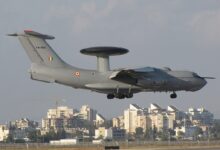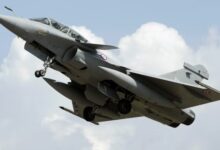Indian Air Force Chief Says That IAF to Start Using 5th-Gen AMCAS In 2035 And Add 6 Squadrons Of Multi-Role Fighters

- The Indian threat scenario and the way wars might be fought in the subcontinent are very different from what is happening between Russia and Ukraine.
- The IAF is not cut off from the rest of society, nor does it want to be. While recruits are a reflection of the society they come from, IAF veterans who retire on superannuation show what the IAF can give back to society.
On October 8, which was IAF Day (IAF turned 90 this year), the CAS talked to this author about how the Indian Air Force has changed from a tactical force to a strategic force.
“The Indian Air Force going from being a tactical force to a strategic force is a natural step that comes from the growth of the country as a whole. With the growth of the country, our threats have also changed.
Today, we’re seeing more and more possible scenarios where people work together, which makes the problem more complicated. The IAF would be the most involved of the three services in “swing operations” between fronts in the Northern Sector if they were needed.
We have made specific plans for these kinds of things to happen and adjusted our position accordingly. With this in mind, assets have been brought in, and a time-bound plan for fixing problems has also been set up.
In line with its national duties, the IAF has also broadened its focus and paid more attention to protecting India’s territorial assets.
He also said, “Now, the IAF needs to become an Aerospace Force. Air and space are part of the same continuum, so functions that have to do with air can easily become functions that have to do with space.
This logic applies to both being aware of what’s going on around you and defending against any threats that come your way. So, the IAF is getting the tools and training it needs to be able to do space-related jobs without any problems. Communications, Navigation, ISR, and Space Surveillance Networks are all areas where the IAF is working to improve its space capabilities.
The Air Chief gave the following “options” when asked how the Indian Air Force will be able to play its role to the fullest when it has fewer active fighter squadrons than its authorised number of squadrons:
LCA(Light Combat Aircraft) – On July 1, the first LCA Squadron was put together. 16 LCA have been sent to the IAF in IOC configuration so far. Also, 10 FOC planes have been given to the IAF, and four more have been told to get ready. HAL has also said that it wants to deliver the last four FOC planes and four IOC twin-seater planes in FY 2022-23. The IAF is also buying 83 LCA Mk 1A, for which HAL and the IAF signed a contract on January 25, 2011. It is planned that deliveries will start in January 2024. Also, the PSQRs for LCA MK 2 D&D have been given to the ADA. The LCA Mk 2 is likely to be put into use after 2030.
AMCA (Advanced Medium Combat Aircraft) – The Advanced Medium Combat Aircraft (AMCA) programme is a fifth-generation fighter aircraft programme that is being developed by the DRDO. The IAF is actively helping the DRDO with this project. The AMCA is likely to be put into place starting in 2035.
MRFA (Medium Range Fighter Aircraft) – The IAF plans to slowly bring in six MRFA squadrons. The programme would be moved forward as part of DAP-2020’s “Make in India” initiative, with a big focus on giving key technologies to an Indian Production Partner. Right now, the case is going on.
On the controversial idea that India should have integrated theatre commands, which was first proposed by the late Chief of Defense Staff Bipin Rawat and is said to have the support of Prime Minister Narendra Modi, the CAS said, “The discussions are going on, and we have covered a lot of ground on this issue. We are confident that the final solution will be the best for this country. It will allow for a “Whole of Nation” approach, using all parts of Comprehensive National Power to protect and advance national security and interests.
Note that the Indian Air Force is very worried about how its assets will be split between the proposed theatre commands. Air Chief Marshal Chaudhari has also thought about how the IAF’s well-known air doctrine will work with the theatre commands.
Aside from the platforms, how does he look at the level of technological skill and the quality of the human resources (including fighter pilots in the face of rising air accidents), and what is the lesson?
When asked about this, the CAS said, “First of all, I’d like to make it clear that air accidents in the IAF are not getting worse.” The number of accidents in the Indian Air Force has been going down steadily over time, and our goal is to bring that number down even further.
Does the Indian Air Force learn anything from the war in Ukraine, which is still going on? The Air Chief replied, “The Indian Air Force is keeping a close eye on the situation there and looking at what we can learn from this conflict.” The Indian threat scenario and the way wars might be fought in the subcontinent are very different from what is happening between Russia and Ukraine.
“However, we are always looking at our capabilities, whether they are related to technology or to human resources, and we make changes as we see the need.
“We are completely sure of the skills of all of our air warriors, and we know that each of them can handle any challenge and still do their jobs well.
“As a force that relies heavily on technology, the Indian Air Force has always been aware of the need for its members to have the right level of technological skill. This gets the right amount of attention in the way we train.
Losses in wartime, like in Ukraine, cannot be confused with “air accidents” that happen in times of peace. The number of accidents for every 10,000 hours of flying is the only measure of accident rates in military aviation that is accepted around the world. On that scale, the IAF has done very well, and the number of accidents has gone down.
The Air Chief also talked about the IAF’s unavoidable ties to the rest of society, especially the uproars over “the Agnipath scheme,” which is a four-year temporary recruitment of young people at the “Jawan” level.
“I have always said that some people’s initial dislike of the Agnipath scheme was mostly based on motives and in a few cases on not knowing enough about it. Indian youth have a lot of faith in the IAF and the defence forces as a whole, as shown by the huge number of responses to the IAF’s notice for batch 01/2022.
“The Agnipath plan isn’t the only one that got a positive response from everyone. Every time they’ve tried to hire new officers or PBORs, the responses have been the same. Many young people have tried more than once to join the IAF. And this happens because people outside the IAF hear from people in blue uniforms that the IAF is a great place to live.
The IAF is not cut off from the rest of society, nor does it want to be. While recruits are a reflection of the society they come from, IAF veterans who retire on superannuation show what the IAF can give back to society.
“The IAF has very strong policies that give every person the same chances. We also try to get people from all over the country, no matter where they come from. We have a well-known online entrance exam that is given to everyone in India,” he said.







Facebook Comments